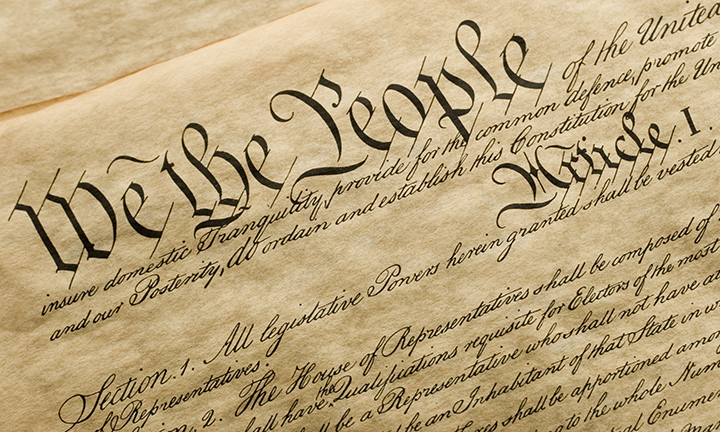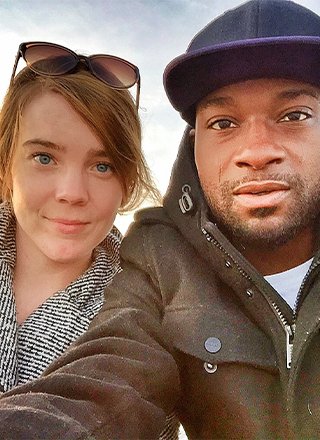
Is the separation of church and state in the Constitution?
Absolutely. Separation of church and state is in the Bill of Rights. Separation of church and state is in the U.S. Constitution.
The separation of church and state is baked into our founding documents and our system of government. Still, plenty of people argue that because the specific phrase “separation of church and state” doesn’t appear word for word in the Constitution, there’s no such thing.
People like the newly elected Speaker of the House Mike Johnson, who worked as a lawyer for Alliance Defending Freedom and recently called this constitutional principle a “misnomer.” Or Congresswoman Lauren Boebert: “I’m tired of this separation of church and state junk. That’s not in the Constitution. It was in a stinking letter, and it means nothing like what they say it does.” Donald Trump’s former press secretary, Kayleigh McEnany, who said on Fox News that “separation of church and state found nowhere in our founding documents.” And Fox News host Pete Hegseth, who bit off more than he could chew against one literate guest.
This argument—that the actual words “separation of church and state” aren’t in the Constitution—is feeble. As you might guess from our name, Americans United for Separation of Church and State, we’ve heard it more times than we can count.
The Powerful Metaphor.
Firstly, yes. Thomas Jefferson penned the wall metaphor in a letter to the Danbury Baptists in 1802. He celebrated the First Amendment for “building a wall of separation between Church & State.” The Supreme Court has endorsed this view many times. First in 1878. And then again “in 1947, 1948, 1961 (three times), 1962, 1963, 1968, 1973, 1977, 1982, and again and again in countless concurrences, dissents, and lower court opinions,” according to a recent law review article. The wall metaphor nicely sums up the relationship.
James Madison also used a similar phrase in a later essay, “Strongly guarded … is the separation between religion and government in the Constitution of the United States.” That’s pretty clear. And he basically wrote the First Amendment and is known as the “Father of the Constitution.”
Does it matter that the words aren’t in the Constitution verbatim? No. Neither is the phrase “fair trial,” but we use that phrase to describe several big rights protected in the Bill of Rights.
The Revolutionary Constitution.
Church-state separation is woven into the very fabric of our Constitution.
Our Constitution was the first to declare that power comes from people, not gods. The words “We the People” are poetic, but so much more. They declared a new source of power.
Our Constitution was the first not to mention a god or deity. Obviously, that was a deliberate choice. At the time, some people objected to the omission, but the framers insisted on a secular text.
Our Constitution was the first to ban religious tests for public office. That ban contains the most clear and emphatic language in a document that’s often deliberately vague. It reads: “NO religious test… SHALL EVER be required as a qualification … TO ANY office or public trust …” That was the only mention of religion in the original, un-amended text.
But that wasn’t enough. The Framers wanted even more. So they wrote the First Amendment: “Congress shall make no law respecting an establishment of religion or prohibiting the free exercise thereof…” Jefferson revered those words so much that he wrote the metaphor that gives AU its name to this day. The amendment includes both the Establishment Clause and the Free Exercise Clause.
The two clauses work together. The separation in the Establishment Clause is one of the primary ways we protect the religious freedom in the Free Exercise Clause. Our Constitution guarantees a secular government; it does this in part to protect religious freedom for all. That’s why religious leaders have backed church-state separation from the earliest days of the American colonies, to the folks who founded AU, to the clergy on AU’s Faith Advisory Council today. True religious freedom needs this separation.
The American Original.
There’s a lot wrong with our Constitution, but those secular ideals are right. They’re also unique. They are real contributions, not just to political science and thought, but to all humanity. They are a pillar of our democracy.
The “wall of separation between church and state” is an American original. It’s an American invention. The idea was born in the Enlightenment. But it was first implemented in the “American Experiment.” Until then, no other nation had sought to protect the people’s right to think freely by separating religion and government. We should be proud of that fact. And we should fight any disinformation that threatens this ideal.
Bookmark this page. And feel free to copy and paste any of these arguments next time you meet this talking point. The precise words may not be in the Constitution, but that core value—the separation of church and state—most definitely is.


